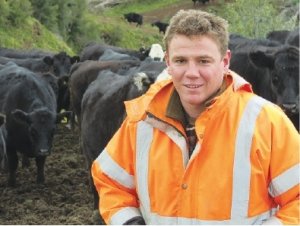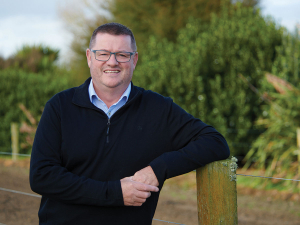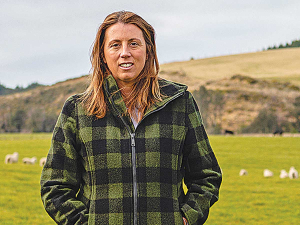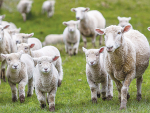Grass is money in his eyes and he won’t let it go into any animal unless he can see a sufficient return in the offering.
The station is 2,500ha of “steep, rolling hill country,” as Bunny puts it, running from 300m to 1200m with 1900ha effective carrying 17,000 stock units. Landcorp Romney ewes and hoggets make up 60% of the stock; the rest are Angus breeding cows and steers, the beef animal of choice on the east coast.
Sam, four permanent staff and two casuals run the station. He became manager of Opouahi in 2010 after stints as a shepherd on several farms, including Smedley Station, a 31,000 stock unit property that incorporates a Cadet Training Farm which Bunny was once a student of, prior to doing a Bcom Ag at Lincoln.
Communication is a big part of his management style and he makes sure his staff understand the ‘big picture’ goals on the property as well as their own individual tasks. He encourages them to share their ideas on the farm and to enjoy their work.
His arrival at Opouahi sort of coincided with the station being designated as one of Landcorps beef monitor farms. The programme is designed to work out how to make more money out of beef cows.
“Beef cow performance has been pretty much stagnant over the last 20 years [while] sheep performance has skyrocketed so we were asked to be the monitor farm,” he explains.
Three or four times a year the station hosts Landcorp managers and staff from across the eastern and central north island region. “Plus some staff from Wellington.”
NAIT technology is being used to monitor cattle and find out what is affecting their performance, then see what can be done to change things.
“One main area is the poor calving percentage, with North Island farmers managing about 88% which means that they’re losing 12 calves in every 100. We’re trying to find out where we’re losing these calves – second scanning’s part of this.
“We’re also monitoring the animals post calving where we tend to lose them to misadventure, such as falling over banks.”
Good grazing management and modest mob-sizes are his answer: shifting big mobs increases the risk of misadventure and having feed readily available means cows don’t have to forage very steep country.
That said, he believes in giving the beef cows a hard time, and believes some farms feed too well. Opouahi’s herd is ‘high performing’ given it does very well on minimal tucker. He says the objective with beef cattle is to limit losses and to use them to groom the pastures for ewes and lambs.
“The reason is that sheep are financially more viable than cattle. Because of that you have to get the best possible performance out of them on the minimum and poorest quality feed available. We work our cows very hard during the winter with the idea of having feed for them at the time they need it, which is calving and when the bull is going out.”
Steers are grown to 18 months then trucked to another Landcorp farm for finishing.
If it wasn’t for the beef cows, sheep performance would not be what it is, says Bunny.
The station winters 8,200 Landcorp Romney ewes and 2,500 hoggets. Ewes did 142% last spring, and hoggets 50% in what was the first time that class of stock had been mated on the property.
The improved lambing percentage, plus hogget contribution, produced 2000 more lambs.
Summers on the station are generally good, with plenty of rain, but winters can be harsh with snow on the tops. Grass doesn’t really get growing until well into October. Lambing is late September – probably not late enough, says Bunny – with weaning first week January. The problem is having enough feed in winter and enough stock to eat it in summer, hence the move to hogget mating. It’s an all grass system and very little supplement is fed, even in winter.
A key challenge, and focus, is having pastures “ready at the right time” for ewes and lambs. Weaning weights have lifted 4kg. Over 11,000 lambs that’s huge, notes Bunny.
Another strategic focus is improved lamb survival scanning to tailing. Given the nature of the property it’s possible to lose 30% to 40%, notes Bunny. Something below 20% is good.
“We do this by setting up pasture on the lower country to lamb on and virtually jamming the ewes in there to lamb. We select the best sheltered paddocks and don’t lamb on the high country. Once the ewes have lambed and are pretty comfortable, then we bring them up to the higher country.”
They also finish lambs well, getting breeding hoggets to weight quickly with a surplus of ewe lambs that can go to other Landcorp farms.









